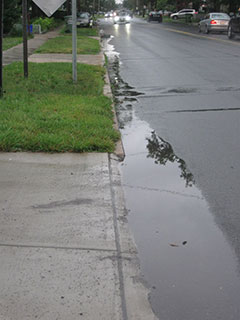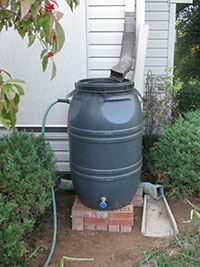
New Jersey receives approximately 45 inches of rainfall per year. Compared to many western states that may receive only 10-12 inches annually, water conservation may seem unimportant in our region. In fact, New Jersey's population consumes water at an increasing rate every year. Current estimates are that one individual uses approximately 120 gallons of water per day. Water usage is at its greatest during the summer due to lawn irrigation.
When practicing organic land care the goal should be to create a drought-resistant lawn and garden that helps protect our vulnerable water supply by:
- increasing soil organic matter, which holds moisture
- promoting deep root growth by mowing high
- utilizing low-maintenance grass species varieties
- incorporating native plants that are adapted to the local climate
- understanding the natural dormancy cycles of cool and warm season grasses
- planting the "right plant in the right place"
Stormwater Runoff
An additional goal of an organic landscape is to ensure that your property does not negatively affect local natural resources including wetlands, streams, and rivers. Most home properties are directly connected to local waterways through the stormdrain system. Our rooftops, driveways, walkways, and compacted lawns generate stormwater runoff when it rains which discharges, without any treatment, directly to local waterways through the stormdrain system. This stormwater runoff becomes polluted with contaminants such as oil, grease, excess fertilizer, pesticides, grass clippings, and pet waste. Polluted stormwater runoff degrades the water quality of local rivers and streams which negatively impacts fish species, drinking water supplies, recreational waterways, and can cause public health concerns when these waterways flood. In New Jersey, based on the 2012 assessment of statewide water quality only
- 41% of waterways fully support their use for drinking water supplies,
- 17% fully support their use as recreational waterways (i.e., swimming and fishing),
- 0.4% fully support their use for fish consumption,
- 58% fully support their use for shellfish harvesting.

Homeowners can reduce stormwater runoff from their properties by directing stormwater to pervious areas where water will naturally soak into the ground. Often these areas already exist such as a healthy lawn, garden, or gravel or mulch walkway. It may be easy to redirect downspouts to these areas. It may be necessary to create areas for stormwater to infiltrate through the use of green infrastructure including rain gardens, permeable pavement, and bioswales. In addition, stormwater runoff can be harvested onsite by using rain barrels or cisterns and stored for later use on a lawn or garden.
In addition, litter, leaf debris, motor oil, animal waste, and household cleaning products should be disposed of properly and never be discharged to the storm drain system.

